The Orchid Mantis is a beautiful mantis species native to the forests of Southeast Asia. They’re most well known for their stunningly beautiful pink and white appearance which resembles an orchid. In addition, they’re famous for their incredible speeds which they use to grab their prey.
As a result of their beautiful appearance and interesting feeding response, the Orchid Mantis has rapidly become a popular pet. As of today, they’re among the most popular pet mantid species.
If you’re interested in getting this beautiful flower mantis as a pet, here is everything you need to know to properly care for them!
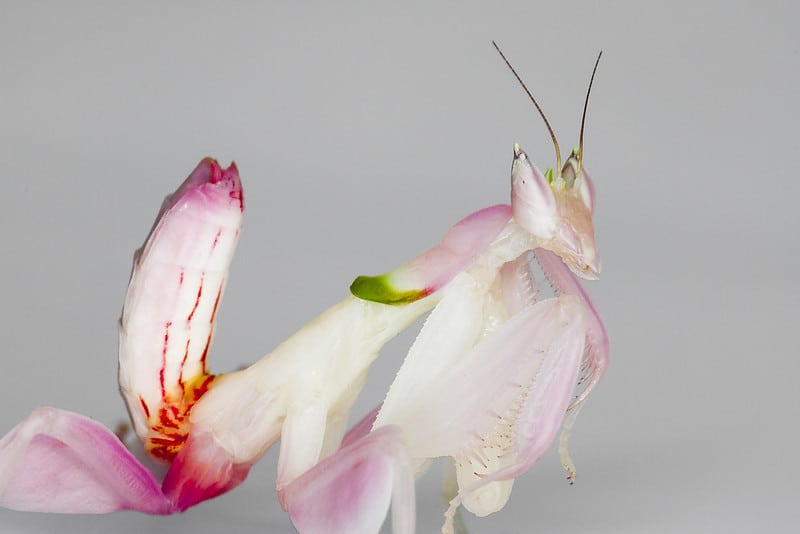
Orchid Mantis Fact Sheet
| Name of species | Hymenopus coronatus |
| Family | Hymenopodidae |
| Common names | Orchid Mantis |
| Category | Mantis |
| Type | Flower Mantis |
| Native location | Southeast Asia |
| Temperature | 77°F to 85°F |
| Humidity | 60% to 80% |
| Size | 1 to 2.5 inches (2.5 cm to 6.5 cm) |
| Diet | Butterflies, moths, flies |
| Lifespan | 5 to 9 months |
| Experience level | Beginner – Intermediate |
Orchid Mantis Overview
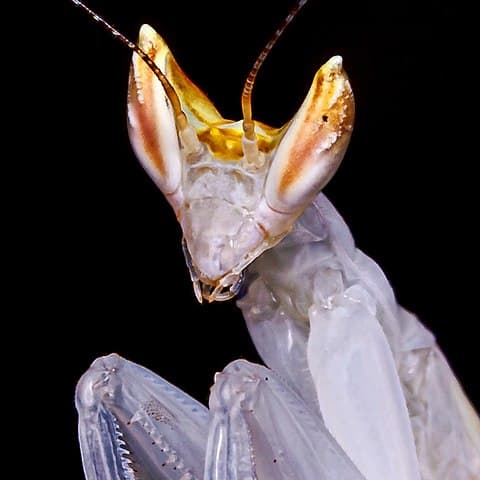
The Orchid Mantis, scientifically known as the Hymenopus coronatus, is a magnificent species that natively inhabits the tropical forests of Southeast Asia. More specifically, it’s found in Malaysia, Myanmar, Thailand, the Philippines, Indonesia, and parts of India.
Though the Orchid Mantis mimics the orchid flower in appearance, they do not actually live on these flowers. Instead, they inhabit another flower that has similar white and pink colors as well as bushes and small trees.
These mantids are strong hunters that rely on ambush predation to take down large prey such as foraging butterflies and other pollinating insects. They capture these insects using their powerful bite and bladed arms.
Appearance & variations
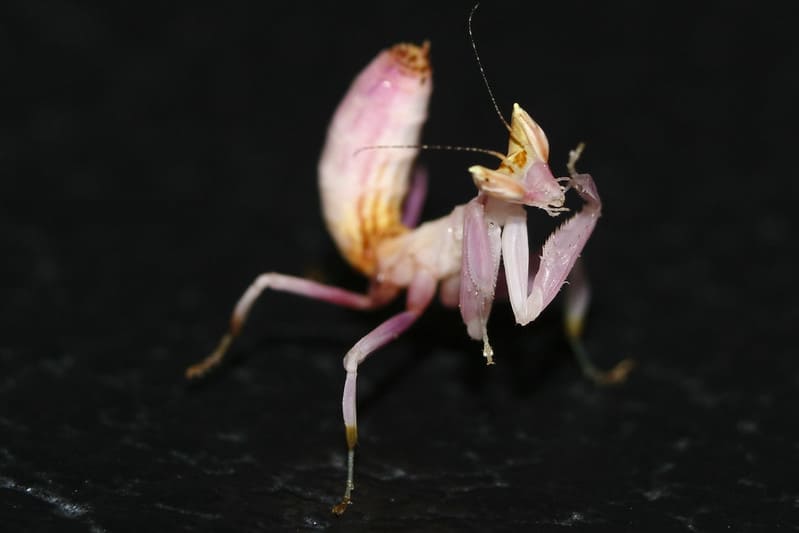
The Orchid Mantis’ name says a lot about what this species looks like. They’re characterized by their pink and white appearance, which makes them closely resemble the orchid flower.
Some specimens are fully white, others are fully pink, but most often they are a mixture of both colors. To further increase the mimicry of the flowers that they inhabit, these mantises have lobes on their legs that mimic flower petals. This flower imitation is very effective and makes the mantis incredibly stealthy.
The first instar of this species looks very different from its fully grown counterpart. The first instar is dark orange in color with a black head and black legs. It’s only after the first molt that the characteristic white and pink colorations become visible.
Furthermore, the Orchid Mantis can actually change color between pink and brown depending on the environment. This is a useful feature for them because it allows them to camouflage themselves no matter the season.
This species exhibits extreme sexual dimorphism with males being much smaller than females. Females can reach a size of around 2.5 inches whereas males typically grow no bigger than 1 inch in length. As a result, it’s very easy to tell males apart from females by size alone.
Nevertheless, size is not the only difference between males and females, they also have different appearances. Males have almost no lobes on their legs, while females have very large lobes. In addition, females have a green spot on their back, while males have a brown spot.
Price
The Orchid Mantis’ fancy appearance does come with a price tag. The price of this species depends on their age and gender, as well as the vendor you buy from, but they’re typically quite expensive compared to other species.
For an L2/L3 Nymph, you can expect to pay around $60, while sub-adult females can cost up to $125.
If you’re looking for an Orchid Mantis for sale, good places to check out include
Behavior and Temperament
The Orchid Mantis is a docile, calm, and skittish species. They’re not dangerous to humans but are extremely lethal to their prey.
They are an ambush predator with lightning-fast movements that catch their prey by surprise. This mantis is very exciting to own due to their interesting hunting style.
To catch their prey, they will use the claws on their rear legs to attach themselves to a twig. Then, they will sway from side to side, which makes them look like a flower. Since they look like a beautiful flower, they will be irresistible to their prey.
In due time, their prey will land on or near them, which is when the mantis strikes and eliminates the prey. They use their strong bite and razor-sharp claws to take down the insect before eating it.
They’re also quite an inquisitive species, and you’ll notice that they spend quite a bit of time climbing and exploring their enclosure.
The Orchid Mantis is relatively calm and docile with humans, but they can be a bit skittish around humans, especially the males, which will fly away at the first sight of danger. This is understandable behavior though since humans are much larger and can crush them in an instant.
Handling
You can handle the Orchid Mantis, but you do have to be very careful when doing so. They’re very fragile insects.
When handling the mantis, try to let them climb onto your hand. That way, you don’t run the risk of accidentally crushing them. In addition, by doing it this way they will perceive your hand as something to climb on rather than a threat.
If you move your hand suddenly to grab them, it’s understandable that they’ll become frightened and act defensively. Defensive reactions include them grabbing you with their claws and biting. Even though they’re not venomous or anything like that, it’s still a stressful situation for your mantis, which is something you want to avoid.
Once they’re in your hand, you can let them walk around. Try to not make any sudden movements as this can spook them which can lead to them trying to fly away or playing dead.
When handling them, make sure you do so close to the floor. If they get spooked they can fall off your hand. Long-distance falls can do a lot of damage, which is why it’s best to handle them close to the floor.
Caring for an Orchid Mantis
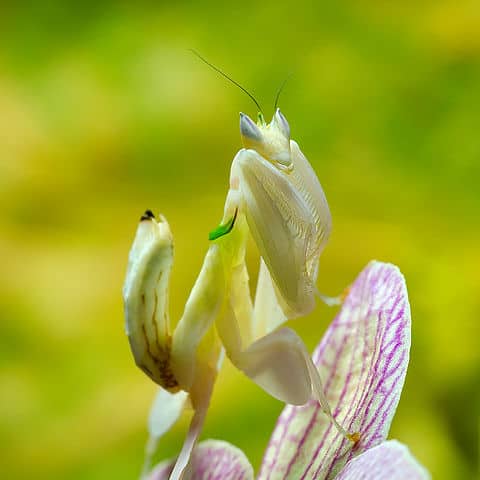
The Orchid Mantis is not particularly difficult to care for. As long as you provide them with enough food, a good enclosure, proper humidity, and a nice temperature, they will be more than happy.
Here’s what they need to thrive.
Tank setup
The minimum enclosure size for an Orchid Mantis is at least 3 times the height and twice as wide as the animal. Of course, a bigger cage doesn’t hurt either and a larger enclosure is typically preferred. However, bigger is not always better, since an enclosure that is too large can make it difficult for your mantis to hunt. A good enclosure size is typically somewhere between 12″x8″x8″ and 12″x12″x12″.
When it comes to decorating the enclosure, you can get as creative as you want. You can choose to create a super fancy bioactive enclosure or keep it simple and provide them only with the basics.
They need a variety of objects to climb on, such as a piece of cork bark, large sticks, and branches. This will not only help them to ambush their prey, but it also gives them a place to hang when molting and a place to hide.
Plants (real or fake) are also good additions to their cage.
Temperature & Humidity
The Orchid Mantis is native to Southeast Asia, a region that’s known for being hot and humid. In captivity, they need an environment that’s similar to their natural habitat.
They do best in temperatures that are around 80°F but can survive in temperatures between 77°F and 85°F.
If your house or apartment is not in this temperature range you might need to use supplemental heating to keep your mantis comfortable. Space heaters, heat lamps, or heat mats are good options that you can use.
As for humidity, relative humidity between 60 and 80% is ideal for this species. This allows them to molt properly and also keeps them comfortable. To keep the humidity at adequate levels misting is recommended.
Ventilation is also very important to prevent the growth of bacteria and mold.
Substrate
The Orchid Mantis does not tend to spend a whole lot of time on the floor, yet substrate is still important.
About 2 inches of substrate is sufficient for this species. Good materials to use include coconut fiber, dry leaves, and sticks.
Watering
Orchid Mantises do not need a water bowl to drink from. Instead, they get most of the moisture they need from the food they eat. The rest that they need they obtain by drinking droplets that accumulate in the enclosure as a result of misting.
Spraying their enclosure is important, but young nymphs prefer a drier environment. Spray the enclosure of the nymph about once a week. As they get older, you can increase the frequency of misting.
Diet & Feeding an Orchid Mantis
The Orchid Mantis primarily eats flying insects such as butterflies, bees, and other pollinators in the wild. In captivity, good food sources for them are house flies and blue bottle flies.
They can also eat the occasional butterfly, hoverfly, grasshopper, moth, or ladybug, but this should not be their primary source of food.
As young nymphs, they should primarily eat small fruit flies that increase in size as the mantis gets bigger.
It’s important to note that the Orchid Mantis will only eat live prey. If you try to feed them dead insects they will not eat them.
Furthermore, it’s recommended that you feed them only captive-bred insects from USDA-approved farms or clean homemade cultures. Wild-caught feeder insects are unfortunately often contaminated with pesticides or parasites which are harmful to your mantis.
Molting
Your Orchid Mantis will molt many times throughout its life. You can tell that it’s about to molt by the fact that it will refuse to eat and that it will hang upside down from a branch motionlessly.
These telltale signs that your mantis is about to molt mean that they’re best left alone for a while. Molting is the shedding of the exoskeleton, which as you can imagine is not the easiest thing in the world. A failed molt can result in lost limbs, which is why it’s so important that you do not disturb them during this time.
In addition, right after a molt, the mantis is very vulnerable because it needs time for its exoskeleton to harden. Do not feed it for 24 hours after a molt, and do not handle it until 48 hours after the molt.
Health & Lifespan
The Orchid Mantis typically lives for around 5 to 9 months. Females often live significantly longer than males. In captivity, it’s easy for them to live out their full lifespan because there are no predators to threaten them.
As long as they’re provided with a healthy diet and a good environment there’s not much preventing them from getting quite old.
To keep the animal healthy, it’s important that you remove uneaten food and have proper ventilation. That way, you can prevent the growth of mold and bacteria which can be harmful to your mantis.
In addition, you should be very careful when handling them. They might not have predators in captivity, but if you decide to handle them it can easily go wrong, so be extremely careful!
Furthermore, stress can impact their health as well. Try to provide them with a stress-free environment as much as possible.
Social Life
You cannot house the Orchid Mantis communally. They’re solitary animals that should always be kept alone. If you try to keep them communally, it’s very likely to end up with one mantis eating the other.
In the wild, these animals are solitary and territorial. They only meet other members of their species when it’s time to mate. In captivity, the same should apply.
If you’re interested in keeping a communal mantis, the Ghost Mantis might be something you’re interested in learning more about.
Breeding the Orchid Mantis
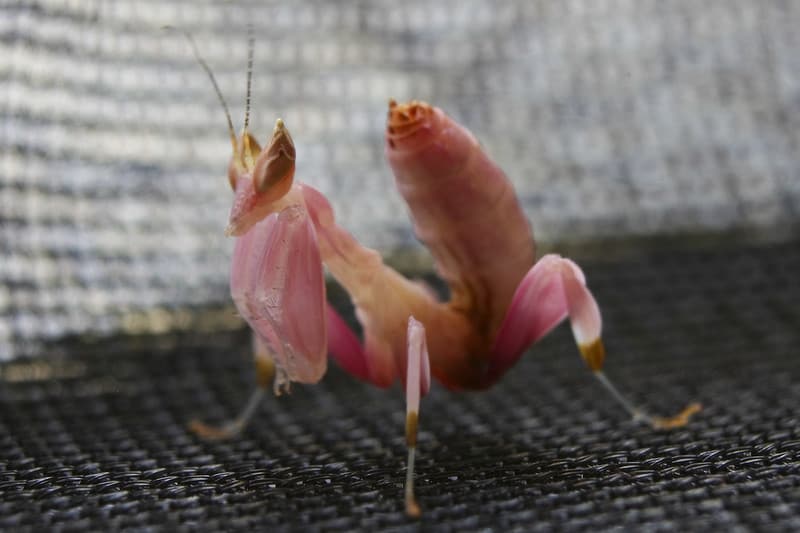
If you want to breed the Orchid Mantis it is important that you determine the sex of the specimens in a timely matter.
The reason for this is that males mature faster and die earlier than females if the development of the males is not slowed down. The most accurate way to determine the sex of a specimen is by counting the abdominal segments.
When you know which animals are male and which are female it’s important that you treat them differently. You have to inhibit the growth of the males by feeding them less and keeping the temperatures lower. For males that you plan to breed, a temperature between 65°F and 68°F is recommended. In addition, you should feed them smaller prey so that they grow slower. Of course, you don’t want to starve them, so keep an eye on their abdomen to determine whether they’re in good condition.
Females, on the other hand, should be fed a lot and kept at high temperatures to speed up their rate of growth and maturation. They should be kept at temperatures of around 95°F and fed extensively.
By treating them differently, males and females will grow at about the same pace. Once you notice that your female is almost fully mature you can start treating the male similarly to the female.
Around 2 to 4 weeks after the last molt you can attempt to mate the male and the female. It’s important that both specimens are well-fed before you introduce them to one another as this increases the likelihood of a successful mating process. A good idea is to introduce the male to the female while she is eating. When she is occupied with her food, she’s much less likely to see the male as dinner.
Once they’re introduced, the male will approach the female and lay on her back. The mating process can take up to a few days. Remove the male once he’s left her back to avoid cannibalism.
If the mating was successful, the female will produce an ootheca (egg sac) which will spawn approximately 150 to 180 young mantises, though many will not survive.
Note: Keep in mind that you only need to treat the males and females this way if you plan on breeding them. If you do not, treat them normally.
Interesting Facts about the Orchid Mantis
- To protect themselves, the first-stage nymphs of the Hymenopus coronatus mimic the bugs of the Reduviidae family. These bugs have a strong bite and foul taste, which helps to deter predators.
- The species was first described in 1792
- According to a study by the American Naturalist, The Orchid Mantis is so good at mimicking a flower that it attracted more bees than any other nearby (real) flower!
- The Orchid Mantis is one of the most dimorphic mantid species
Final words
The Orchid Mantis is without a doubt one of the most beautiful mantis species in the world. Their white and pink colors have made them the favorites of many insect keepers around the world and for good reason.
However, their appearance is not the only interesting thing about them. They’re also excellent hunters that are a joy to watch.
Furthermore, since they’re quite easy to care for, they’re suitable for beginners as well as expert insect keepers. The only drawback is their price, but in my opinion, they’re well worth the price tag. However, if you’re looking for a cheaper species you might be interested in the Chinese or Carolina Mantis instead.
If you’re looking for a pet mantis that will wow your friends, the Orchid Mantis is not to be overlooked!
- How Long Do American Eskimo Dogs Live? Important Factors and Care Tips - September 29, 2023
- Do American Bulldogs Need Grooming? Essential Tips and Care Guidelines - September 29, 2023
- Do Bengal Cats Enjoy Playing? Essential Tips for Keeping Them Active - September 29, 2023